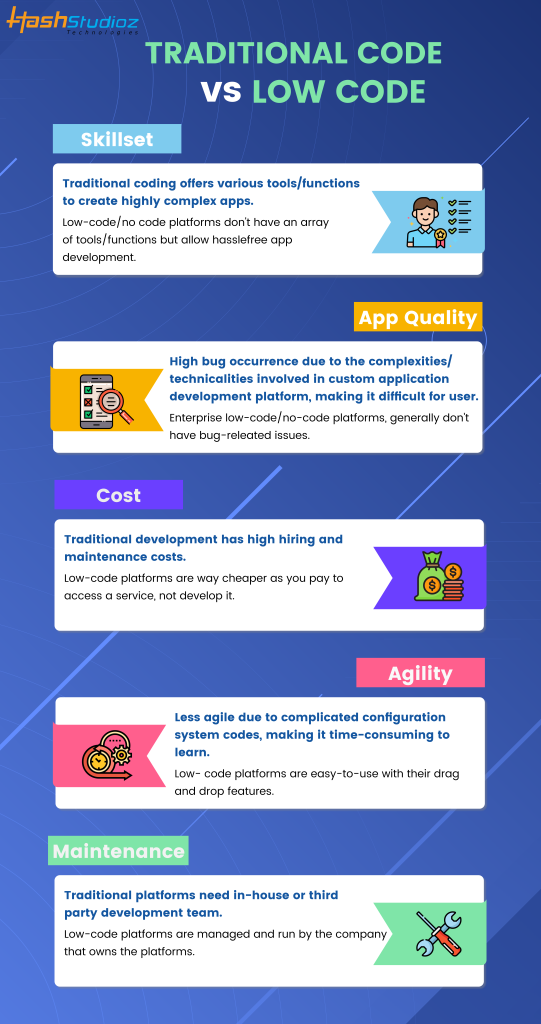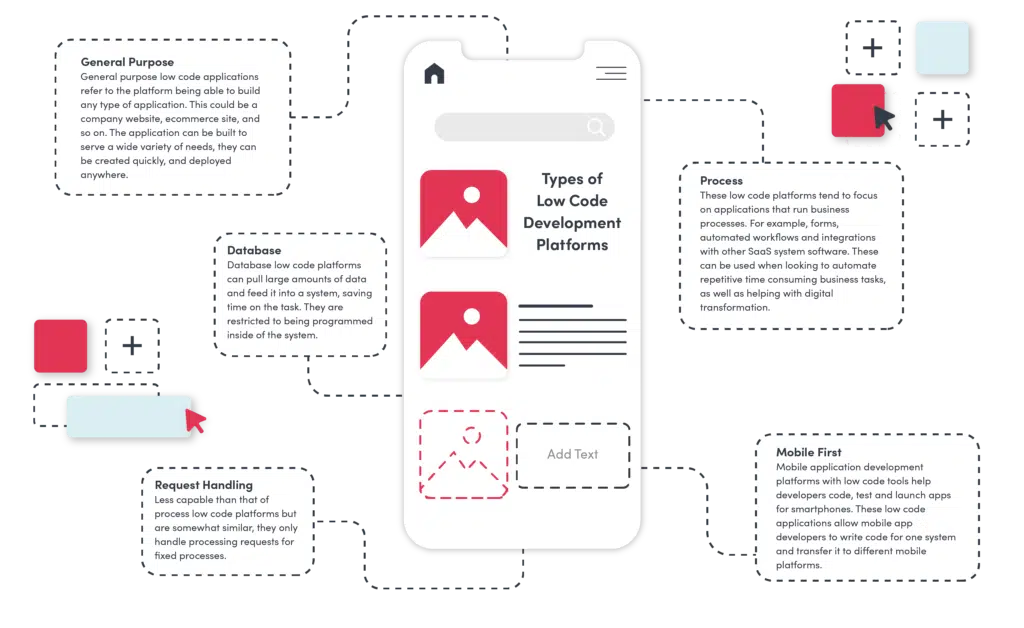Handy Advice For Picking Low-Code Platform Recommendations
Wiki Article
Benefits Of Developing Applications Using Low-Code In Terms Of Integration Capabilities
Low-code development of applications offers huge advantages when it comes to integration capabilities, which are crucial for building applications that can seamlessly integrate with diverse systems and services. Here are some of the benefits that come with pre-built connectors, APIs and other tools:
Wide Range of Connectors Low-code platforms generally come with a vast library of pre-built connectors for popular enterprise systems (e.g., CRM, ERP and cloud services such as databases,). The integration process is simplified.
API Integration: A lot of Low-Code platforms come with out-of-box API integration tools that allow developers to quickly connect external services and data resources.
Simple to Use:
Drag-and -Drop integration Integration tasks are typically completed using drag and drop interfaces. Developers and non-developers can set up sophisticated integrated systems without writing code.
Visual Workflow Designers: These tools assist you in understanding and implementing integrations more easily.
Standardized Integration Methods:
SOAP and RESTful Service : The support for web services standardization like SOAP and REST facilitates easy integration with a variety of external systems.
OData, Other Standards Support for standards like OData helps to transfer and manipulation of data across platforms and applications.
Real-Time Data Synchronization:
Real-Time Integrations: Low-code platforms are capable of handling real-time data sync between systems and applications. This guarantees that information is current and consistent across the entire organization.
Event-Driven architecture: Certain platforms can support event-driven architectures. This allows apps to respond to events in real-time and is crucial for interactive and dynamic apps.
Legacy System Integration:
Low-code platforms: These can be used to connect legacy systems to modern systems. They are a great way to modernize your IT infrastructure without the need to completely overhaul your IT infrastructure.
Data Migration Tools Data Migration Tools: Data migration tools built-in facilitate the transfer of data from outdated systems to the latest applications developed using low-code platforms.
Integration of Third Party Services:
Integration with Cloud Services: Seamless integration with cloud services like AWS, Azure, and Google Cloud allows for the simple deployment and scaling of applications.
Integration of Business Applications: Lowcode platforms can be used to integrate different business applications, such as Salesforce, SAP, Microsoft Dynamics etc., creating a cohesive workflow that spans different functions of business.
Simplified Data Processing
Unified Data models: Certain low-code platforms offer unified data modeling that simplifies data integration and management across different platforms.
Data Connectors - Pre-configured connectors that provide easy access to, and manipulation of data from diverse sources.
Security and Compliance
Secure Integrations: Low code platforms ensure that integrations are compatible to security protocols as well as standard safeguarding data while in transport as well as at rest.
Security Features: These platforms typically contain features that ensure integrations comply with regulations (e.g., GDPR, HIPAA), providing assurance for companies that handle sensitive information.
Extensibility:
Low-code platforms can often accommodate complex integration requirements by adding custom scripts or code. They offer flexibility without compromising the ease of use.
Plug-in Ecosystems: A plug-in ecosystem can be used to extend the integration capabilities and permit users to expand the functionality as needed.
The overall low-code platform's capabilities to integrate makes it an effective tool to create interconnected applications that are scalable and efficient. They make it easier to connect different platforms. They also help improve data flow. View the top breaking news for Low-code Platform for application development for site tips including develop cross platform mobile app, multiplatform mobile app development, cross platform mobile app development, develop mobile application, database in azure, database in azure, rad application development, develop web app, rad application development, sso azure and more.

Low-Code Apps Are Affordable.
Low-code application development has numerous advantages, including cost-effectiveness. It is a popular option for businesses who want to optimize development budgets without compromising on quality. These are the main advantages: Reduced development costs:
Less Coding Requirements: The low code platforms eliminate the need for lengthy, hand-coded applications. Developers can take less time and energy creating applications. This results in lower labor costs.
Less developers: Since low code development is faster and simpler, there are fewer specialized developer resources required. This can drastically reduce costs of staffing and hiring.
Speedier time to market
Accelerated Cycle of Development Visual tools that are low-code and components enable rapid development of applications, which lets businesses launch their new products quicker. This can lead to faster revenue growth and improved positioning in the market.
Rapid prototyping: By constructing and testing prototypes quickly, businesses can reduce the time they spend in the development phase and also allow for faster revisions based on user feedback.
Reduce Maintenance Costs
Simple Maintenance: Software developed with low-code platforms are typically simpler to maintain because of their standardized components and modular architecture. Maintenance and support costs are reduced.
Automated Updates: Many low-code software platforms manage patches and updates in a way that is automatic, ensuring applications remain secure and up-to-date, without the need for large manual intervention.
Efficient Resource Utilization:
Platform contributions that are low-code let businesses as well as others who are not developers to take part in the creation process. This empowers businesses to use the skills of their employees and decrease the dependence on high-paying programmers.
Improved utilization of IT resources IT departments will be able concentrate on strategic initiatives, instead of being bogged down in mundane development tasks. This will improve overall efficiency and productivity.
Scalable Pricing Models
Subscription pricing: Many low-code platform offer flexible pricing plans for subscriptions that increase with use. This allows business to align spending with actual needs and growth, while avoiding huge upfront costs.
Pay-Assosiated Options: Some platforms provide pay-assosiated choices. They ensure that businesses are only liable for the services used which is advantageous to small and new businesses with limited funds.
Reduced costs of third-party software:
Low-code platforms usually come with integrated functionalities that eliminate the requirement to purchase additional tools or software. This can help you save money on subscriptions and licensing costs.
Integrations pre-built: These systems and services are integrated with other popular services, which eliminates the requirement for custom-designed software, and can save time and money.
Increased ROI:
More efficient return on investment (ROI) Through the combination of rapid development, less expense and a quicker time to the market, companies can achieve an increased ROI on their apps.
Enhanced agility: Businesses can adjust quickly to changes in the market or in customer demand which enables them to remain relevant and benefit from new opportunities.
Reduced Training Costs
Low-Code Platforms have User-Friendly Interfaces. The intuitive and user-friendly interfaces help ease the learning curve of new users. This minimizes the requirement for extensive training programs.
Accessible Resources: Many low-code platforms offer extensive tutorials and training materials and also community support. These tools reduce the requirement for formal education and its associated costs.
Collaboration is made easier:
Enhance Collaboration Tool: The built-in collaboration tool helps improve collaboration and communication among team members. This results in faster development processes and reduces project overhead.
Unified Development Environment. A single unifying software development environment could streamline processes and reduce the complexity and cost of managing different software and platforms.
In the end, the value of low-code application development stems in its ability to lower maintenance and development costs as well as speed up time to market, maximize the utilization of resources, and offer flexibility in pricing. All of these factors provide huge financial benefits to companies and make low-code development a viable choice for organizations aiming to maximize their development budgets and create robust, scalable, and high-quality applications. Follow the top Enterprise application development with Low-code Platform for site advice including application development platforms, azure sql server, app modernisation, mobile app development platforms, develop web application, develop mobile application, app platforms, rapid app development, develop cross platform mobile app, azure sql databases and more.

Benefits Of Low-Code Application Development In Terms Of Community Support And Vendor Support
Low-code platforms have significant advantages both in terms of community involvement and vendor support and vendor support, both of which are crucial to the an effective implementation, maintenance and improvement of software. Here are some key advantages.
Comprehensive Technical Support:
Support Teams: Several platforms that make use of low-code offer designated support teams that can assist with technical problems as well as troubleshooting and advice.
24/7 Support Availability: Some vendors offer around-the-clock support which is particularly useful for global businesses operating across different time zones.
Training and Onboarding
Training programs that are structured: Vendors provide structured courses such as webinars or courses for certification. This allows users to quickly get to grips with the platform.
Many companies offer customized onboarding to help customers utilize the platform effectively and customize it to meet the needs of their customers.
Updates and regular updates:
Continuous Improvements: Low-code vendors regularly release updates with improvements in performance, new features and security patches to ensure that the platform is up-to-date.
Feedback Integration Vendors incorporate user feedback into the development process, making sure that the platform is updated to meet changing needs.
Comprehensive Documentation:
Documentation: Comprehensive documentation is available for most products. It covers everything from the basics to the most advanced customisation. It helps users locate solutions for themselves.
API References: API documentation is detailed and aids developers in integrating APIs with other platforms as well as modify their applications.
Professional Services and Consulting:
Expert Consulting: Many companies offer consulting services for architectural planning, strategic planning and complicated implementations. This assists users maximize their platform's potential.
Custom Development Services Some vendors provide custom development services to create specific integrations and features that aren't available in the standard.
Community Support for the Community
Active User Groups:
Discussion boards and forums A lot of platforms with low-code feature a vibrant community where users can get help, discuss solutions, and work together to discover the most effective methods.
Local and virtual User Groups: These groups provide opportunities to network, learn and share knowledge.
Collaboration and sharing of knowledge:
Community-Contributed Resources: Users often share templates, modules, and extensions that they have developed, which can be reused or adapted by others, accelerating development and innovation.
Crowdsourced Problem-Solving: The collective expertise and collective knowledge of a community can be a valuable source to solve problems and come up with creative solutions to complex problems.
Learning and Development:
Community-led training: Many groups hold workshops, training sessions and webinars. They are typically conducted by experts in the field, who provide practical advice as well as advanced techniques.
Online Tutorials and Courses: The community members frequently make online tutorials, courses and tutorials on how to do things that help students learn more.
Feedback and Influence
Product Feedback Channels: Community forums typically offer feedback channels to the vendor, which can influence the development of new features or improvements.
Beta Testing Programs: Members of the community who are active could be able to take part in beta testing programs that give the opportunity to test new features and a voice in determining the future of the platform.
Recognition and Assistance:
Community Recognition Programs: Many companies offer recognition programs that recognize the contributions made by the active members of their community and include MVP (Most Valuable Professionals) programs.
Peer Support : Community members offer support to other peers by sharing their experiences and offering guidance. They build a supportive and supportive culture by sharing their knowledge.
The combination of robust vendor support, and an active and engaged community, provides a comprehensive ecosystem of support for development with low-code. This means that users will are able to access the resources knowledge, expertise, and collaborative opportunities to develop, deploy, and maintain their apps, ultimately enhancing productivity and innovation.
